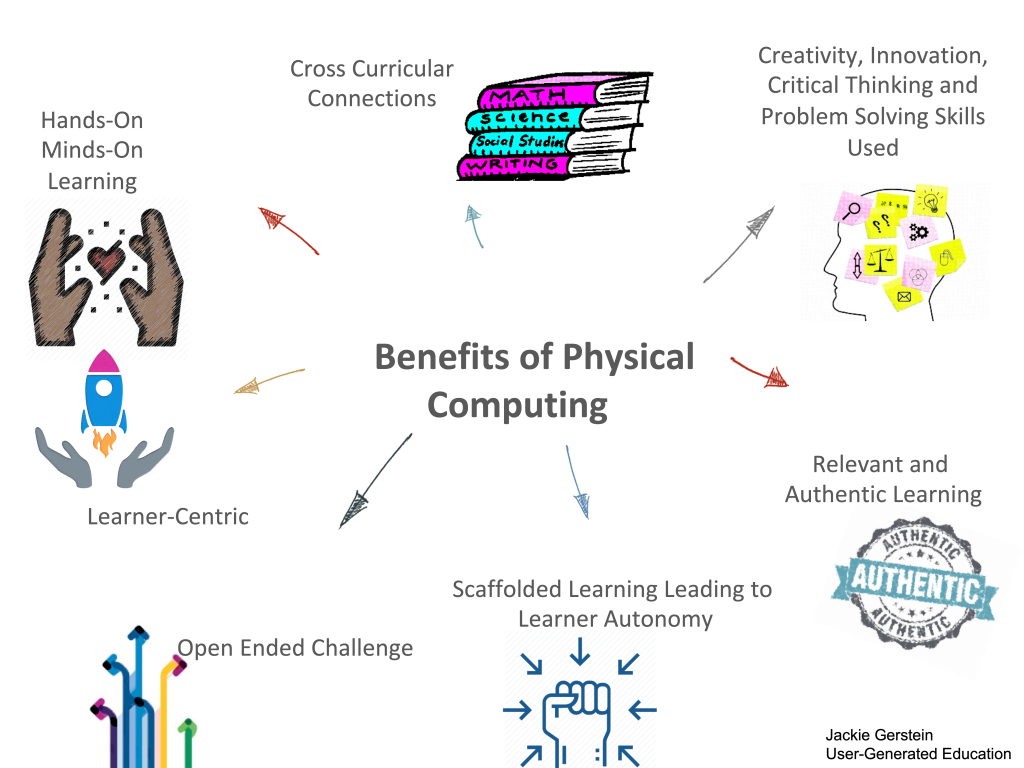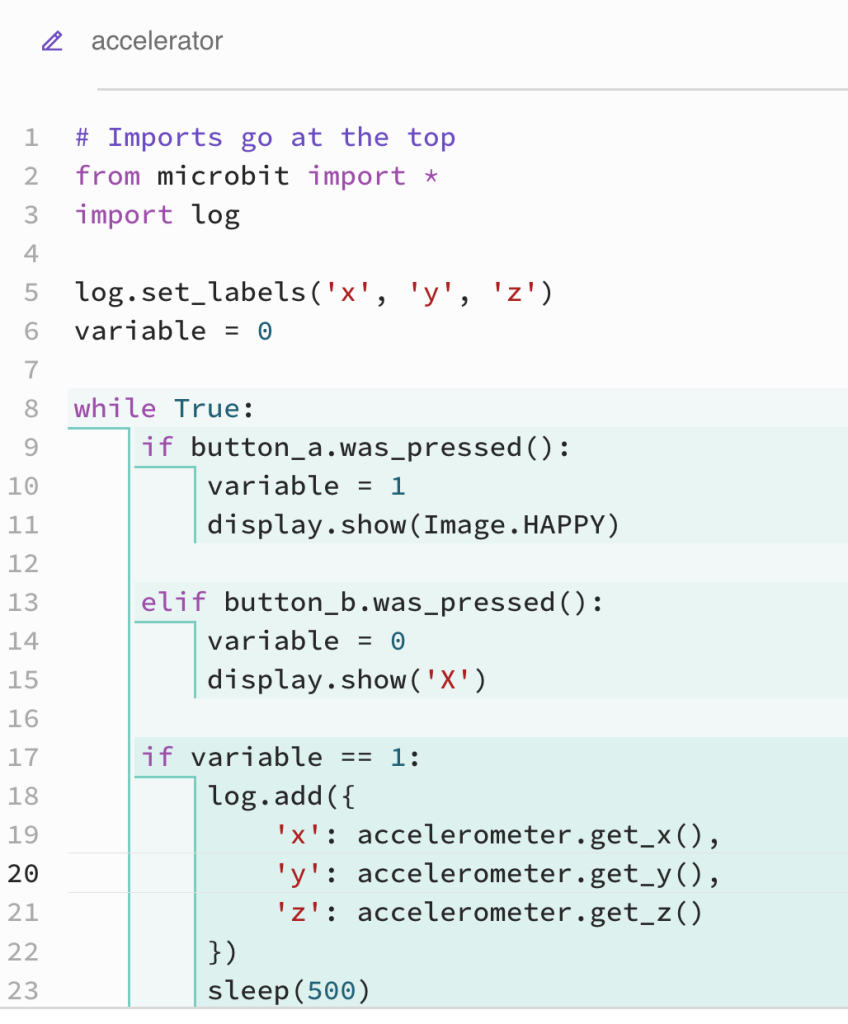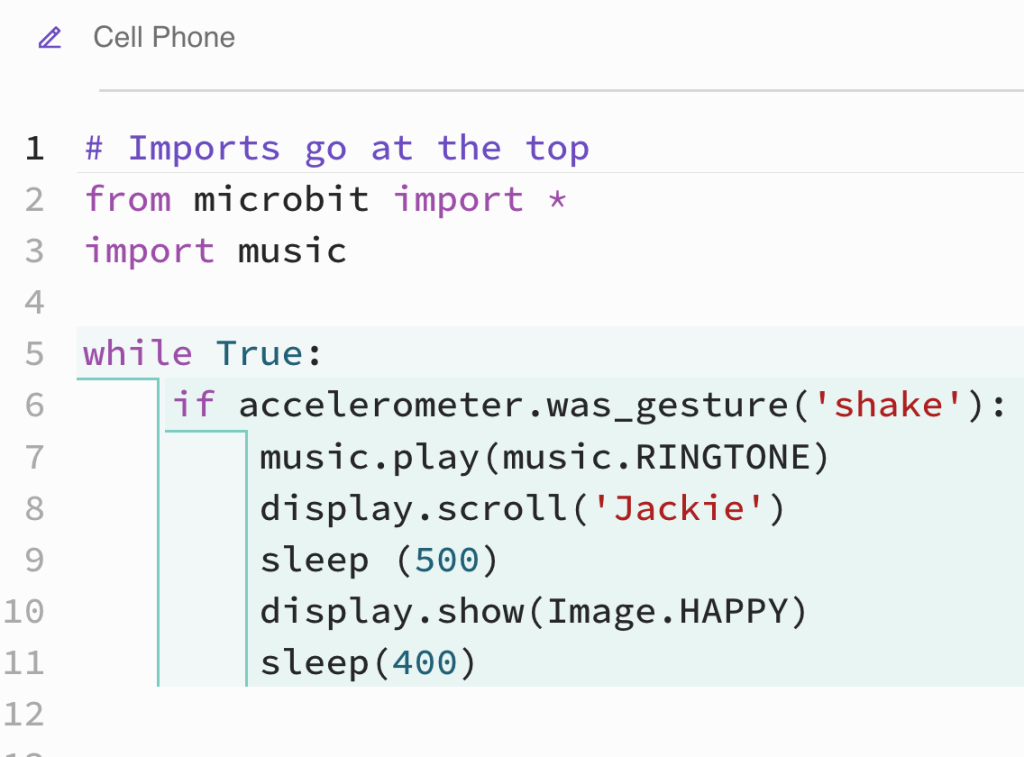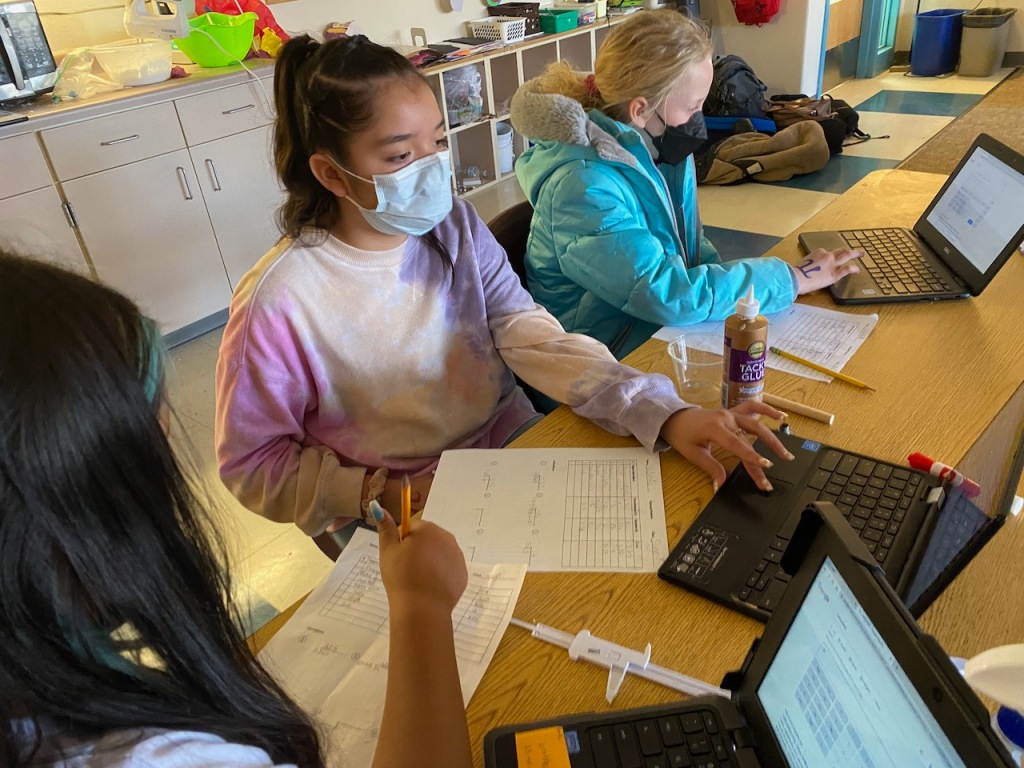Posts Tagged ‘math education’
Advanced micro:bit Projects: Artificial Intelligence/Teachable Machine, the Data Logger Spoon Race, and micro:bit Pal Coded with Python
I love bringing physical computing into my classrooms:
Physical computing refers to the use of tangible, embedded microcontroller-based interactive systems that can sense the world around them and/or control outputs such as lights, displays and motors. Assembling the hardware elements of a physical computer and programming it with the desired behavior provides a creative and educational experience. A variety of physical computing devices are established in the market, including: Arduino, Raspberry Pi, Circuit Playground, and the BBC micro:bit (https://www.microsoft.com/en-us/research/project/physical-computing/)
. . . but as with all use of educational technologies, I believe that it should be used intentionally to assist learners in developing and expanding their content knowledge and life skills.
Standards Addressed
ISTE Standards for Students
- Know and use a deliberate design process for generating ideas, testing theories, creating innovative artifacts or solving authentic problems.
- Develop, test and refine prototypes as part of a cyclical design process.
- Exhibit a tolerance for ambiguity, perseverance and the capacity to work with open-ended problems.
- Create original works or responsibly repurpose or remix digital resources into new creations.
Next Generation Science Standards
- Analyze data from tests to determine similarities and differences among several design solutions to identify the best characteristics of each that can be combined into a new solution to better meet the criteria for success.
- Develop a model to generate data for iterative testing and modification of a proposed object, tool, or process such that an optimal design can be achieved.
Math Standards
- Measure angles in whole-number degrees using a protractor. Sketch angles of specified measure.
- Graph points on the coordinate plane to solve real-world and mathematical problems.
Artificial Intelligence, the Teachable Machine, and micro:bits
Thanks, Cora Yang, for this!
The Data Logger Spoon Race with micro:bits and MakeCode
Thanks, Katie Henry and Jacqueline Russell, for this!
The micro:bit Python editor can also be used to code the data logger for the spoon race:
micro:bit Pal Coded with Python
Python is an excellent first text-based language to learn. Its instructions and syntax are based on natural language, making code easy to read, understand and modify. As well as being widely used in education, it’s used in industry, especially in the areas of data science and machine learning. Python is not just used by software developers, but also by people working in fields as diverse as medicine, physics and finance. Python on the BBC micro:bit brings the benefits of physical computing to students aged 11-14, learning programming fundamentals through text-based coding: immersive, creative experiences for students that help build engagement and knowledge (https://microbit.org/get-started/user-guide/python-editor/).
Here is a micro:bit pal coded with Python example that I will share with my students:
. . . and the code is:
Here are some student micro:bit pals coded with Python:
Pi Day: An Example of an Interdisciplinary, Engaging Lesson
I have the privilege of teaching my gifted elementary students at two Title 1 schools for multiple years. Each year I have special thematic days for which the students get very excited, e.g., Halloween and Day of the Dead “Wars,” Valentines Day, Book Celebrations, and Pi Day. I love planning a variety of interdisciplinary activities for these days. It is like planning parties. I want to give them memories of positive school experiences that last a lifetime. When I announce these upcoming celebrations, the students who have been in my program for multiple years cheer loudly. My new students then get excited, too.
I’ve blogged about the value of interdisciplinary units before – All Lessons Should Be Interdisciplinary https://usergeneratededucation.wordpress.com/2019/01/13/all-lessons-should-be-interdisciplinary/

Pi Day Activities
The day consisted of the following activities:
- Introduction – Pi Day Trivia
- Book: Sir Cumference
- Kahoot Pi Games
- Digital Breakout
- Making and Decorating Pies
- Measuring for Pi
- Stations
- Pi Fortune Teller
- Pi Sky Line
- Race to Pi Card Game
Standards Addressed
A variety of cross-disciplinary content standards were addressed during this lesson.
Common Core Math Standards:
- CCSS.MATH.CONTENT.7.G.B.4
Know the formulas for the area and circumference of a circle and use them to solve problems; give an informal derivation of the relationship between the circumference and area of a circle. - CCSS.MATH.CONTENT.5.MD.A.1
Convert among different-sized standard measurement units within a given measurement system, and use these conversions in solving multi-step, real world problems.
Common Core English Language Arts Standards:
- CCSS.ELA-LITERACY.RI.6.7
Integrate information presented in different media or formats (e.g., visually, quantitatively) as well as in words to develop a coherent understanding of a topic or issue. - CCSS.ELA-LITERACY.RI.5.10
By the end of the year, read and comprehend informational texts, including history/social studies, science, and technical texts, at the high end of the grades 4-5 text complexity band independently and proficiently.
National Core Art Standards:
- Generate and conceptualize artistic ideas and work.
- Refine and complete artistic work. (https://www.nationalartsstandards.org/)
Pi Day Trivia
Students were introduced to Pi and Pi Day through the following videos:
Sir Cumference
The students then were shown a reading of Sir Cumference and the First Round Table (A Math Adventure) by Cindy Neuschwander:
Join Sir Cumference, Lady Di of Ameter, and their son Radius for wordplay, puns, and problem solving in this geometry-packed math adventure. King Arthur was a good ruler, but now he needs a good ruler. What would you do if the neighboring kingdom were threatening war? Naturally, you’d call your strongest and bravest knights together to come up with a solution. But when your conference table causes more problems than the threat of your enemy, you need expert help. Enter Sir Cumference, his wife Lady Di of Ameter, and their son Radius. With the help of the carpenter, Geo of Metry, this sharp-minded team designs the perfect table conducive to discussing the perfect plan for peace (https://www.amazon.com/Cumference-First-Round-Table-Adventure/dp/1570911525).
Pi Kahoots
My students cheer when we do Kahoot quizzes. The Kahoot quizzes made and submitted by other teachers make it so easy to use. Here are the two Pi Kahoots I did with the students:
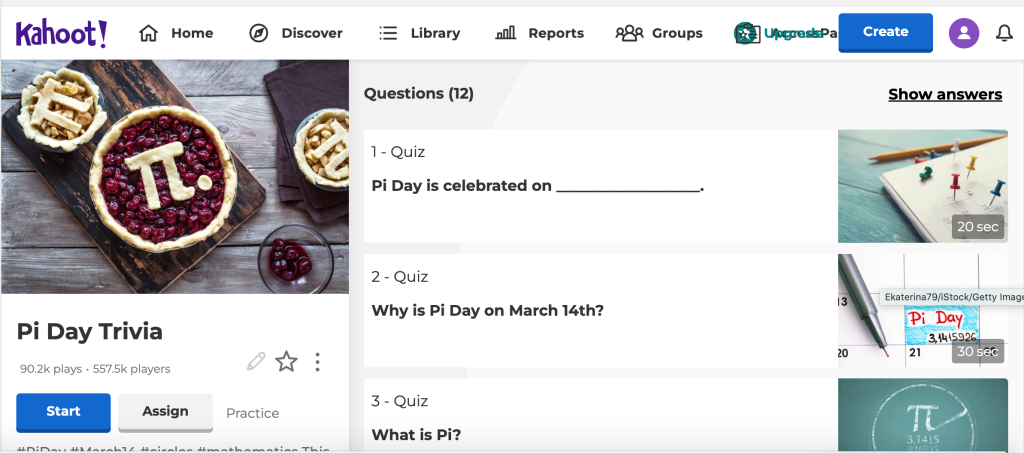
Accessed at: https://create.kahoot.it/details/0210be57-ce68-489a-9054-d9165b8165ff

Accessed at: https://create.kahoot.it/details/pi-day-trivia/a7605cd3-4c93-4c13-bc23-eec96da2a627
Digital Breakout EDU – Pi Day
Breakout EDU is an immersive learning games platform. Breakout EDU games consist of a combination of physical and digital puzzle elements that must be solved in a set amount of time. Players of all ages are challenged to open the locked Breakout EDU box using critical thinking, collaboration and creativity. (https://orrhslibrary.weebly.com/what-is-breakout-edu.html).
Here is the Pi Day Digital Breakout EDU game they did.

Can be accessed at https://platform.breakoutedu.com/game/play/pi-day-digital-breakout-4th-6th-grades-90608 .
Making and Decorating Pies



One of the activities students enjoy the most during Pi day is making pies. They were given ingredients and recipes for:
- Oreo Cookie Pie – https://littlespoonfarm.com/no-bake-lemon-icebox-pie-recipe/
- Lemon Pie – https://littlespoonfarm.com/no-bake-lemon-icebox-pie-recipe/
- Strawberry – https://www.justapinch.com/recipes/dessert/pie/strawberry-icebox-pie.html
- Graham cracker crust (for use in the Pi pan) – https://www.callmepmc.com/how-to-make-a-no-bake-graham-cracker-crust/
- Royal Icing (for decorating the pies) – https://www.chsugar.com/recipe/royal-icing-with-meringue-powder
They needed to follow the recipe which included figuring out the directions and using measurements. I even bought a Pi pan for them to use. After the pies were made, they decorated them with Pi symbols and characters.
Measuring for Pi
With tape measures in hand, groups of students carefully measure the circumferences and diameters of various round objects. The class makes a table of measured values and calculates the quotients. When they see time and time again the same answer result from division, whether it be from big circular objects or small ones—eureka!—they will have unwittingly discovered π for themselves (http://ccssimath.blogspot.com/2013/03/the-life-of-pi.html).
I created a competition to see which team could achieve Pi based on their measurements of diameters and circumferences of real world objects. I watched as they struggled with and learning about circumferences, diameters, and pi; about doing accurate measurement; about converting fractions into decimals to do their calculations; and about using the Pi formula.
Stations
Students could choose from the following stations to complete their Pi days.
Pi Fortune Teller
Pi Graph Skyline
Directions for this activity can be found at https://carrotsareorange.com/pi-day-activities/.
Race to Pi Card Game
Directions can be found at https://mathgeekmama.com/pi-day-card-game/.
Pi Day: An Example of an Interdisciplinary, Engaging Lesson
I have the privilege of teaching my gifted elementary students for multiple years. At my one school, I have them in class for a full day each week, and each year I have special thematic days for which the students get very excited, e.g., Halloween and Day of the Dead “Wars,” Valentines Day, Book Celebrations, and Pi Day. I love planning a variety of interdisciplinary activities for these days and I love watching how 100% are fully engaged for the entire time.
I’ve blogged about the value of interdisciplinary units before – All Lessons Should Be Interdisciplinary https://usergeneratededucation.wordpress.com/2019/01/13/all-lessons-should-be-interdisciplinary/

Pi Day Activities
The day consisted of the following activities:
- Digital Breakout
- Making and Decorating Pies
- Book: Sir Cumference
- Measuring for Pi
- Kahoot Pi Games
Standards Addressed
Common Core Math Standards:
- CCSS.MATH.CONTENT.7.G.B.4
Know the formulas for the area and circumference of a circle and use them to solve problems; give an informal derivation of the relationship between the circumference and area of a circle. - CCSS.MATH.CONTENT.5.MD.A.1
Convert among different-sized standard measurement units within a given measurement system, and use these conversions in solving multi-step, real world problems.
Common Core English Language Arts Standards:
- CCSS.ELA-LITERACY.RI.6.7
Integrate information presented in different media or formats (e.g., visually, quantitatively) as well as in words to develop a coherent understanding of a topic or issue. - CCSS.ELA-LITERACY.RI.5.10
By the end of the year, read and comprehend informational texts, including history/social studies, science, and technical texts, at the high end of the grades 4-5 text complexity band independently and proficiently.
ISTE Standards for Students:
- Students plan and employ effective research strategies to locate information and other resources for their intellectual or creative pursuits.
- Students collect data or identify relevant data sets, use digital tools to analyze them, and represent data in various ways to facilitate problem-solving and decision-making.
21st Partnership for 21st Century Skills:
- Collaborate with others
- Demonstrate ability to work effectively and respectfully with diverse teams
- Exercise flexibility and willingness to be helpful in making necessary compromises to accomplish a common goal
- Assume shared responsibility for collaborative work, and value the individual contributions made by each team member
Digital Breakout EDU – Pi Day
So what is this about Digital Breakout EDU games? Simply put, it’s taking the same concept, but turning it all digital. Participants are given a one-page site that includes text, images and links to clues, some of which may be misleading. There is a Google Form embedded on the page where you submit your answers to a series of “lock” questions and each lock will immediately tell you if you’re successful (http://wordpress.barrow.k12.ga.us/21stcenturytips/?p=6989).
To start off our Pi day activities, students did a Pi Day Digital Breakout EDU game.

Can be accessed at https://platform.breakoutedu.com/game/play/pi-day-digital-breakout-4th-6th-grades-90608 .
Making and Decorating Pies


One of the activities students enjoy the most during Pi day is making pies. They were given ingredients and recipes for:
- Apple Pie – https://www.thespruceeats.com/easy-apple-pie-recipe-for-kids-2097625
- Chocolate Peanut Butter Pie – https://happyhourprojects.com/chocolate-peanut-butter-pies/
- Royal Icing (for decorating the pies) – https://www.chsugar.com/recipe/royal-icing-with-meringue-powder
They needed to follow the recipe which included figuring out the directions and using measurements. After the pies were made, they decorated them with Pi symbols.
Sir Cumference
The students then were shown a reading of Sir Cumference and the First Round Table (A Math Adventure) by Cindy Neuschwander:
Join Sir Cumference, Lady Di of Ameter, and their son Radius for wordplay, puns, and problem solving in this geometry-packed math adventure. King Arthur was a good ruler, but now he needs a good ruler. What would you do if the neighboring kingdom were threatening war? Naturally, you’d call your strongest and bravest knights together to come up with a solution. But when your conference table causes more problems than the threat of your enemy, you need expert help. Enter Sir Cumference, his wife Lady Di of Ameter, and their son Radius. With the help of the carpenter, Geo of Metry, this sharp-minded team designs the perfect table conducive to discussing the perfect plan for peace (https://www.amazon.com/Cumference-First-Round-Table-Adventure/dp/1570911525).
Measuring for Pi


With tape measures in hand, groups of students carefully measure the circumferences and diameters of various round objects. The class makes a table of measured values and calculates the quotients. When they see time and time again the same answer result from division, whether it be from big circular objects or small ones—eureka!—they will have unwittingly discovered π for themselves (http://ccssimath.blogspot.com/2013/03/the-life-of-pi.html).
Pi Kahoots
Using Kahoot wasn’t planned for the day but the students asked for it. I love that they ask for learning tasks. The Kahoot quizzes made and submitted by other teachers make it so easy to use them spontaneously. Here are the two Pi Kahoots I did with the students:

Accessed at: https://create.kahoot.it/details/pi-day/877d64ee-3003-4a30-9d82-f1cd81721749

Accessed at: https://create.kahoot.it/details/pi-day-trivia/a7605cd3-4c93-4c13-bc23-eec96da2a627
Qualities of Effective Educator Professional Development
Most administrators and teachers believe in the importance and value of professional development. Sadly, though, too many teachers believe that those mandatory, one-size-fits-all professional development sessions offered by their schools are a waste of time and money.
Randi Weingarten, president of the American Federation of Teachers, said in a statement, “Even high quality professional development must be directly relevant to the needs of teachers and genuinely improve teaching and learning.” Weingarten said. “And low-quality professional development, frankly, feels like detention.” (New Report Reveals That Teacher Professional Development Is Costly And Ineffective)
Teacher professional learning is of increasing interest as a critical way to support the increasingly complex skills students need to learn in order to succeed in the 21st century. Sophisticated forms of teaching are needed to develop student competencies such as deep mastery of challenging content, critical thinking, complex problem solving, effective communication and collaboration, and self-direction. In turn, effective professional development (PD) is needed to help teachers learn and refine the instructional strategies required to teach these skills. However, research has noted that many professional development initiatives appear ineffective in supporting changes in teachers’ practices and student learning.(Effective Teacher Professional Development)
What follows are the general guidelines I use to plan and structure my professional development workshops. Recently, I facilitated two weekends of math instruction for elementary teachers. I use these workshops as a reference in this discussion.
- Voluntary
- Models Best Classroom Practices
- Active and Hands-On
- Fun and Engaging
- Engages the Mind, Body, Emotions
- Time to Tinker and Play
- Collaboration
- Ability to Tailor to Own Needs
- Natural Integration of Technology
- Reflection Built In

Voluntary
Teacher PD needs to be voluntary.
The fact that adults are voluntary participants in the learning situation has profound implications for how learning occurs. They are generally highly motivated and primed to get the most out of the situation as possible. They will tackle tasks with enthusiasm, provided they are seen as relevant. This means that they are more likely to embrace participatory learning techniques such as discussion, role playing, small group work and the analysis of personal experiences.
The reverse side of voluntary participation by adults is that they can just as easily withdraw. Unlike the disruption that occurs when participation is mandatory, adults are likely to do one of two things. They will either quietly withdraw altogether or, if that is not really an option, they will continue to show up and do what is minimally expected of them, but will essentially become passive participants. (Principles underlying Effective Practices in Adult Education)
My weekend math workshops were offered to elementary teachers in a specific school district as a voluntary opportunity. A grant did provide them with a stipend for attending but as one of the attending teachers noted, “Even with a stipend, I wouldn’t volunteer for a weekend workshop unless I was interested in learning how to be a better teacher of math” (in this case).
Models Best Classroom Practices
First and foremost, teacher PD needs to model best classroom practices. “Curricular models and modeling of instruction provide teachers with a clear vision of what best practices look like” (Effective Teacher Professional Development). If the desire is to have educators create and implement engaging, interactive, and fun learning activities, then PD needs to be a mirror of these practices. I always believed that is is hypocritical to lecture about these best practices. It should be a process of modeling.
In order to model best classroom practices during my math workshops:
- I used videos, mostly from The Teaching Channel, to show elementary teachers modeling best practices in math within their own elementary classrooms.
- I did math activities with the teacher participants as if they were students in my elementary classroom.
Active and Hands-On
Active learning engages teachers directly in designing and trying out teaching strategies, providing them an opportunity to engage in the same style of learning they are designing for their students. Such PD uses authentic artifacts, interactive activities, and other strategies to provide deeply embedded, highly contextualized professional learning. This approach moves away from traditional learning models and environments that are lecture based and have no direct connection to teachers’ classrooms and students. (Effective Teacher Professional Development)
Other than explaining activities, showing videos and presenting some technology options, all of learning activities during the weekend workshop were hands-on and active.


Fun and Engaging
Somewhere along the line of professional development, it became a way too serious endeavor. I believe this is a major reason why teachers don’t enjoy their professional development opportunities.
Fun has a positive effect on motivation levels, determining what we learn and how much we retain. If the learning isn’t fun, it won’t be effective. That’s not just a sneaking suspicion – it’s cold, hard, scientific fact.
- A study in the journal, College Teaching, found that students could recall a statistics lecture more easily when the lecturer added jokes about relevant topics.
- In her book, Neurologist, Judy Willis showed how fun experiences increase levels of dopamine, endorphins, and oxygen – all things that promote learning.
- In a study for the Journal of Vocational Behaviour, Michael Tews found that employees are more likely to try new things if their work environment is fun. (Why Fun in Learning is Important)
Regardless of age, grade, content area, one measure of success I use is the quantity of laughter and squeals of joy. I heard lots of laughter during my workshops.
Engages the Mind, Body, Emotions
As an experiential educator and regardless of the age level I am teaching, I emphasize multi-sensory, whole person learning.
We learn best when we think, feel and do. That’s the message of Dr. Adele Diamond, a cognitive developmental neuroscientist who currently teaches at the University of British Columbia in Canada. We might refer to this as “whole body learning.” According to Dr. Diamond, the executive function of the brain — the prefrontal cortex — works best when we go beyond the rational mind by also involving emotions and physical behaviors. That makes sense since the more we involve other parts of the brain, the more neural connections we make that reinforce learning. (Brain Research: To Improve Learning, Use Whole Body)
My math workshop was not exception as activities that use the body, mind, and emotions were introduced to the participating teachers.
Time to Tinker and Play
Teachers and librarians, like their students, need hands-on experience with tools and with playing to learn as that helps them build creative confidence. (Crafting Professional Development for Maker Educators)
Teachers, during PD, should be provided with time, resources, and materials with which to play. It sets the expectation that they will be active agents of their own learning. It gives them the message it is okay to play and experiment with the materials; that tinkering is often needed as a part of learning new skills.
Given that the nature of the workshop was hands-on and active, workshop participants were time to tinker with the resources and materials provided.
Ability to Tailor to Own Needs
One of the justified complaints of teachers regarding their schools’ professional development is that it is often of the too generic, one-size-fits all variety. To be effective, professional develop should help teachers address their own classroom needs. Participating teachers were given lots of resources and opportunities to develop math activities specific for their grade level and students.
Integrates Collaboration
High-quality PD creates space for teachers to share ideas and collaborate in their learning, often in job-embedded contexts. By working collaboratively, teachers can create communities that positively change the culture and instruction of their entire grade level, department, school and/or district. (Effective Teacher Professional Development)
At the beginning of the workshop, participants were asked to form groups with same grade level teachers forming what I called mini-PLNs. Part of the workshop time was devoted to teachers developing materials for their own classrooms and students. During the time, the teachers could work with their mini-PLNs. They were also asked to share, throughout the weekend, the activities they discovered and developed. These sharing sessions often led to feedback and ways the activities could be modified for a variety of student populations.


Naturally Integrates Technology
Technology use within all learning and teaching environments including professional development should be ubiquitous; it’s use should be determine by its potential to enhance and increase learning.
During my math workshop, participants used technology to:
- Access the workshop slides.
- Explore learning activities for the manipulatives I provided: dice, pool noodles, Legos. playing cards, beach balls.
- Try out online math games: ABCya, Toy Theater Math, Prodigy, and Code.org.
- Take photos of math examples in school building.
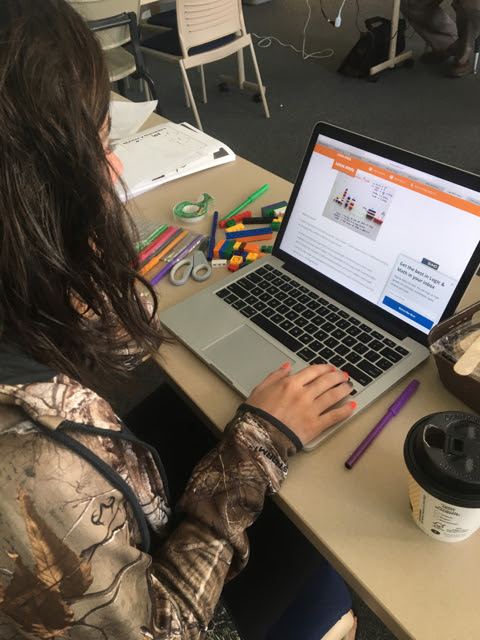

Builds in Reflection
High-quality professional learning frequently provides built-in time for teachers to intentionally think about, receive input on, and make changes to their practice by facilitating reflection and soliciting feedback. Feedback and reflection both help teachers to thoughtfully move toward the expert visions of practice. (Effective Teacher Professional Development)
As a final reflection for the weekend, I asked participating teachers to use the following prompt to create a mini-poster of their learning. It also modeled how to use such a reflection process with their students.
. . . and here is a video recording of one of the participating teacher’s reflections:
As a parting shot, here are the slides I used during the workshop:
